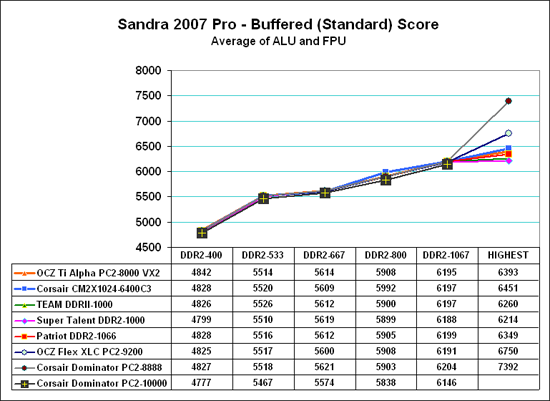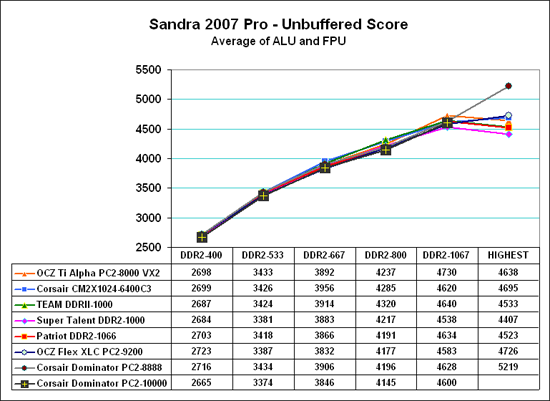Corsair Dominator PC2-10000: Fastest DDR2
by Wesley Fink on January 31, 2007 2:00 AM EST- Posted in
- Memory
Memory Bandwidth Scaling
Memory bandwidth normally improves with increases in memory speed and reductions in memory timings. This is best illustrated using Performance Scaling charts.
Since results for high-end memory were so close at all tested speeds, the scale range was reduced to better show the small differences in these memory benchmark results. Please keep this in mind when viewing the charts, since a normal zero scale would make performance differences appear much smaller than these expanded scale charts. Test values for memory at each speed are included below each chart for reference.
To evaluate memory bandwidth SiSoft Sandra 2007 Professional was used to evaluate standard Buffered performance and Unbuffered memory bandwidth.

The most widely reported Sandra score is the Standard or Buffered memory score. This benchmark takes into account the buffering schemes like MMX, SSE, SSE2, SSE3, and other buffering tools that are used to improve memory performance. The Buffered benchmark does not correlate well with real performance differences in games, so our memory bandwidth tests have always included an Unbuffered Sandra memory score. The Unbuffered result turns off the buffering schemes, and we have found the difference in Unbuffered results correlate well with real-world performance differences.

In both Buffered and Unbuffered tests Corsair Dominator 10000 performance curves compare to the best tested to the top tested speed of DDR2-1066 on the ASUS 975X based motherboard. Dominator 10000 requires slightly slower timings at DDR2-1066 than the top OCC Flex and Dominator PC2-8888. This translates into bandwidth that is lower than the other top memories at this speed. While the differences are extremely small, and don't show well in the charts, both Standard and Unbuffered bandwidth is at the low end of tested memory at all speeds. This high-speed memory is binned for top speed and not low latency, and you can see that reflected in slightly lower bandwidth in test results.
Performance with Version 1.5 of Super Pi was also compared. The Super Pi test compared the time to calculate 2 million places of Pi at the different memory speeds. This benchmark measures pure number crunching.

Super Pi results continue to improve to the highest speed that could be reached with stability with Corsair Dominator 10000 and other tested memories. What also stands out is how close the results with all the memories really are from DDR2-400 to DDR2-1066.. This is mainly a reflection of the fact that the compared memories are based on the same base Micron memory chips.
Memory bandwidth normally improves with increases in memory speed and reductions in memory timings. This is best illustrated using Performance Scaling charts.
Since results for high-end memory were so close at all tested speeds, the scale range was reduced to better show the small differences in these memory benchmark results. Please keep this in mind when viewing the charts, since a normal zero scale would make performance differences appear much smaller than these expanded scale charts. Test values for memory at each speed are included below each chart for reference.
To evaluate memory bandwidth SiSoft Sandra 2007 Professional was used to evaluate standard Buffered performance and Unbuffered memory bandwidth.

The most widely reported Sandra score is the Standard or Buffered memory score. This benchmark takes into account the buffering schemes like MMX, SSE, SSE2, SSE3, and other buffering tools that are used to improve memory performance. The Buffered benchmark does not correlate well with real performance differences in games, so our memory bandwidth tests have always included an Unbuffered Sandra memory score. The Unbuffered result turns off the buffering schemes, and we have found the difference in Unbuffered results correlate well with real-world performance differences.

In both Buffered and Unbuffered tests Corsair Dominator 10000 performance curves compare to the best tested to the top tested speed of DDR2-1066 on the ASUS 975X based motherboard. Dominator 10000 requires slightly slower timings at DDR2-1066 than the top OCC Flex and Dominator PC2-8888. This translates into bandwidth that is lower than the other top memories at this speed. While the differences are extremely small, and don't show well in the charts, both Standard and Unbuffered bandwidth is at the low end of tested memory at all speeds. This high-speed memory is binned for top speed and not low latency, and you can see that reflected in slightly lower bandwidth in test results.
Performance with Version 1.5 of Super Pi was also compared. The Super Pi test compared the time to calculate 2 million places of Pi at the different memory speeds. This benchmark measures pure number crunching.

Super Pi results continue to improve to the highest speed that could be reached with stability with Corsair Dominator 10000 and other tested memories. What also stands out is how close the results with all the memories really are from DDR2-400 to DDR2-1066.. This is mainly a reflection of the fact that the compared memories are based on the same base Micron memory chips.










22 Comments
View All Comments
Wesley Fink - Wednesday, January 31, 2007 - link
We make no attempt in our memory testing to max out the overclock on the CPU. In general we try to choose settings that will yield CPU speeds that are consisitent and relatively near stock speed - so they can be compared to other results.This CPU can OC with stability to 3.9 to 4.0 GHz as you saw in our Tuniq 120 Tower review. Running memory at high overclocks combined with high CPU overclcoks will definitely produce much higher benchmark numbers. However, the reality remains that the memory component alone contributes much less to high performance than CPU speed or the GPU used in benchmarking.
If you look closely at performance results for the 680i on p.4 you will see we included both 1:1 (same speed, really 1:2) and 5:4 linked ratio tests. The 5:4 has 20%+ higher buffered bandwidth at DDR2-1315 than the 1:1 measures at the same DDRS-1315, yet gaming performance is almost the same. Memory does make a difference in performance, but memory speed matters much less on C2D and AM2 than it did on previous processors.
sdsdv10 - Wednesday, January 31, 2007 - link
They why are companies working so hard to bring out the ultra-fast, ultra-expensive memory modules?
coldpower27 - Wednesday, January 31, 2007 - link
Bragging rights, and premium prices. They are also trying to prey on the misinformed who don't know any better.Sunrise089 - Wednesday, January 31, 2007 - link
Are you just posting to brag? That's definately a nice PC you have, but how does it compare to the one in the review? You have a much more overclocked processor AND a generation more GPU power.semo - Wednesday, January 31, 2007 - link
the second page has "2x2048" in the title. is that the name of the product? wasn't the test done on 2x1024 kit whereas the title suggests a 4gb kit.Wesley Fink - Wednesday, January 31, 2007 - link
If you check the chart on page 1 you will see Twin2x2048-10000C5DF is the Corsair Part Number for this 2GB kit with 2x1GB dimms and a Dominator Airflow fan. It has become common in the memory industry to sell memory in pairs rated by the capacity of the pair of dimms. We agree this can be confusing, but we used the Corsair Part Number to identify the modules since readers have asked us for that info in past reviews.semo - Wednesday, January 31, 2007 - link
thanks Wesley, i had a feeling it was something like that. i'll pay more attention next time.Live - Wednesday, January 31, 2007 - link
What if you put this in the DFI Lanparty UT ICFX3200-T2R/G does it beat the 680i?tuteja1986 - Wednesday, January 31, 2007 - link
Good memory but way too expensive. I would rather buy 8800GTX.tayhimself - Wednesday, January 31, 2007 - link
Who buys this junk anyway?